Papers by Vivian Mushahwar
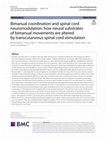
Journal of neuroengineering and rehabilitation, Jun 18, 2024
Humans use their arms in complex ways that often demand two-handed coordination. Neurological con... more Humans use their arms in complex ways that often demand two-handed coordination. Neurological conditions limit this impressive feature of the human motor system. Understanding how neuromodulatory techniques may alter neural mechanisms of bimanual coordination is a vital step towards designing efficient rehabilitation interventions. By non-invasively activating the spinal cord, transcutaneous spinal cord stimulation (tSCS) promotes recovery of motor function after spinal cord injury. A multitude of research studies have attempted to capture the underlying neural mechanisms of these effects using a variety of electrophysiological tools, but the influence of tSCS on cortical rhythms recorded via electroencephalography remains poorly understood, especially during bimanual actions. We recruited 12 neurologically intact participants to investigate the effect of cervical tSCS on sensorimotor cortical oscillations. We examined changes in the movement kinematics during the application of tSCS as well as the cortical activation level and interhemispheric connectivity during the execution of unimanual and bimanual arm reaching movements that represent activities of daily life. Behavioral assessment of the movements showed improvement of movement time and error during a bimanual common-goal movement when tSCS was delivered, but no difference was found in the performance of unimanual and bimanual dual-goal movements with the application of tSCS. In the alpha band, spectral power was modulated with tSCS in the direction of synchronization in the primary motor cortex during unimanual and bimanual dual-goal movements and in the somatosensory cortex during unimanual movements. In the beta band, tSCS significantly increased spectral power in the primary motor and somatosensory cortices during the performance of bimanual common-goal and unimanual movements. A significant increase in interhemispheric connectivity in the primary motor cortex in the alpha band was only observed during unimanual tasks in the presence of tSCS. Our observations provide, for the first time, information regarding the supra-spinal effects of tSCS as a neuromodulatory technique applied to the spinal cord during the execution of bi-and unimanual arm movements. They also corroborate the suppressive effect of tSCS at the cortical level reported in previous studies. These findings may guide the design of improved rehabilitation interventions using tSCS for the recovery of upperlimb function in the future.
Series on Bioengineering and Biomedical Engineering, 2017

Journal of Medical Robotics Research, 2020
This review focuses on the development of intelligent, intuitive control strategies for restoring... more This review focuses on the development of intelligent, intuitive control strategies for restoring walking using an innovative spinal neural prosthesis called intraspinal microstimulation (ISMS). These control strategies are inspired by the control of walking by the nervous system and are aimed at mimicking the natural functionality of locomotor-related sensorimotor systems. The work to date demonstrates how biologically inspired control strategies, some including machine learning methods, can be used to augment remaining function in models of complete and partial paralysis developed in anesthetized cats. This review highlights the advantages of learning predictions to produce automatically adaptive control of over-ground walking. This review also speculates on the possible future applications of similar machine learning algorithms for challenging walking tasks including navigating obstacles and traversing difficult terrain. Finally, this review explores the potential for plasticity ...
Sensors and Actuators B: Chemical, 2018
A wearable passive microwave sensor was developed to detect lesions deep in the human body Le... more A wearable passive microwave sensor was developed to detect lesions deep in the human body Lesion phantoms as small as 0.5 mL can be detected by the sensor Lesion phantoms can be detected through a layer of human tissue that is thicker than 140 mm The increase in lesion size resulted in an increase in lesion score The sensor may be effective in detecting lesions early in their development, thus allowing for early intervention to reduce the impact of disease.
IEEE transactions on biomedical circuits and systems, Aug 9, 2016
Neural pathways can be artificially activated through the use of electrical stimulation. For indi... more Neural pathways can be artificially activated through the use of electrical stimulation. For individuals with a spinal cord injury, intraspinal microstimulation, using electrical currents on the order of 125 μ A, can produce muscle contractions and joint torques in the lower extremities suitable for restoring walking. The work presented here demonstrates an integrated circuit implementing a state-based control strategy where sensory feedback and intrinsic feed forward control shape the stimulation waveforms produced on-chip. Fabricated in a 0.5 μ m process, the device was successfully used in vivo to produce walking movements in a model of spinal cord injury. This work represents progress towards an implantable solution to be used for restoring walking in individuals with spinal cord injuries.
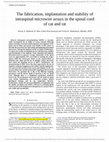
IEEE transactions on neural systems and rehabilitation engineering : a publication of the IEEE Engineering in Medicine and Biology Society, Mar 1, 2017
Intraspinal microstimulation (ISMS) is currently under investigation for its ability to restore f... more Intraspinal microstimulation (ISMS) is currently under investigation for its ability to restore function following spinal cord injury and aid in addressing basic investigations of the spinal cord in feline and murine (rat) models. In this report we describe the procedures for fabricating and implanting intraspinal microwires, with special emphasis on the rat model. We also report our results on targeting success and long-term stability and functionality of the implants. Early targeting with implants fabricated based on general "average" dimensions of the spinal cord was approximately 50% successful in reaching the proper targets within the ventral grey matter in cats. Improvements in insertion technique and the use of multiple contact electrodes have raised the targeting success to 100%. Furthermore, the manufacturing of ISMS arrays has been improved by the use of magnetic resonance imaging to create subject-specific implants for cats and track the location of the arrays p...
2023 IEEE International Conference on Robotics and Automation (ICRA)

Artificial Organs
BackgroundSpinal cord injury causes a drastic loss in motor and sensory function. Intraspinal mic... more BackgroundSpinal cord injury causes a drastic loss in motor and sensory function. Intraspinal microstimulation (ISMS) is an electrical stimulation method developed for restoring motor function by activating the spinal networks below the level of injury. Current ISMS technology uses fine penetrating microwires to stimulate the ventral horn of the lumbar enlargement. The penetrating wires traverse the dura mater through a transdural conduit that connects to an implantable pulse generator.ObjectiveA wireless, fully intradural ISMS implant was developed to mitigate the potential complications associated with the transdural conduit, including tethering and leakage of cerebrospinal fluid.MethodsTwo wireless floating microelectrode array (WFMA) devices were implanted in the lumbar enlargement of an adult domestic pig. Voltage transients were used to assess the electrochemical stability of the interface. Manual flexion and extension movements of the spine were performed to evaluate the mech...

Advanced Intelligent Systems
Healthcare systems are burdened by mobility impairments resulting from aging and neurological con... more Healthcare systems are burdened by mobility impairments resulting from aging and neurological conditions. One of the recent advances in robotics is lower limb assistive/rehabilitative devices that can make independent living possible. Nonetheless, some limitations need to be addressed before robotics can be used in home‐based applications. This paper describes the current state of the art in intelligent motion planning and control of lower limb assistive devices, which have addressed some of these challenges. Adaptable central pattern generators and the divergent component of motion are introduced as methods for personalized motion planning based on physical human–robot interaction (pHRI). Uncertainty analysis for neural networks is introduced to increase safety in motion planning based on pHRI. For the case that a user cannot apply physical interaction, a reinforcement‐learning‐based approach is introduced to switch between different modes of walking based on the user's input v...
2022 International Conference on Rehabilitation Robotics (ICORR)

Artificial Organs
BackgroundIntraspinal microstimulation (ISMS) has emerged as a promising neuromodulation techniqu... more BackgroundIntraspinal microstimulation (ISMS) has emerged as a promising neuromodulation technique for restoring standing and overground walking in individuals with spinal cord injury. Current and emerging ISMS implant designs connect the electrodes to the stimulator through lead wires that cross the dura mater. To reduce possible complications associated with transdural leads such as tethering and leakage of cerebrospinal fluid, we aim to develop a wireless, fully intradural ISMS implant based on our prior work in the cortex with the Wireless Floating Microelectrode Array (WFMA). Although we have extensive data about WFMA cortical stability, its mechanical and electrical stability in the spinal cord remains unknown. One of the quantifiable metrics to assess long‐term implant stability is mechanical strain.ObjectiveThe aim of the current work is to develop a method to assess implant stability by measuring strain fields in a surrogate of the human spinal cord.MethodsA physical model ...

IEEE/ASME Transactions on Mechatronics
This article presents a strategy for autonomous locomotion trajectory planning for high-level con... more This article presents a strategy for autonomous locomotion trajectory planning for high-level control of lower limb exoskeletons by defining a novel set of adaptive central pattern generators (ACPGs) to facilitate safe and compliant interaction with the human. A time-varying bounded-gain adaptive disturbance observer is designed for estimating the human–robot interaction (HRI) needed for online central pattern generator (CPG)-based trajectory shaping and low-level nonlinear trajectory tracking control. The proposed ACPG dynamics for each exoskeleton joint updates the motion frequency and amplitude based on the observed HRI torque, which is also coupled with adjacent joints’ CPGs to regulate their phase differences in real time. An integrated Lyapunov analysis is conducted to ensure the closed-loop system’s stability and uniformly ultimately boundedness of both the tracking error and the torque estimation error in the controlled exoskeleton. Experimental studies are performed with an able-bodied human wearer by applying arbitrary torques on the exoskeleton’s joints in order to evaluate the proposed autonomous control strategy in online adjustment and personalization of the locomotion.
The Neuroscientist, 2020
Noisy stimuli may hold the key for optimal electrical stimulation of the nervous system. Possible... more Noisy stimuli may hold the key for optimal electrical stimulation of the nervous system. Possible mechanisms of noise’s impact upon neuronal function are discussed, including intracellular, extracellular, and systems-level mechanisms. Specifically, channel resonance, stochastic resonance, high conductance states, and network binding are investigated. These mechanisms are examined and possible directions of growth for the field are discussed, with examples of applications provided from the fields of deep brain stimulation or spinal cord injury. Together, this review highlights the theoretical basis and evidence base for the use of noise to enhance current stimulation paradigms of the nervous system.
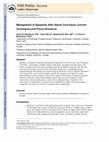
Neurorehabilitation and Neural Repair, Sep 1, 2009
Spasticity, resulting in involuntary and sustained contractions of muscles, may evolve in patient... more Spasticity, resulting in involuntary and sustained contractions of muscles, may evolve in patients with stroke, cerebral palsy, multiple sclerosis, brain injury, and spinal cord injury (SCI). The authors critically review the neural mechanisms that may contribute to spasticity after SCI and assess their likely degree of involvement and relative significance to its pathophysiology. Experimental data from patients and animal models of spasticity as well as computer simulations are evaluated. The current clinical methods used for the management of spasticity and the pharmacological actions of drugs are discussed in relation to their effects on spinal mechanisms. Critical assessment of experimental findings indicates that increased excitability of both motoneurons and interneurons plays a crucial role in pathophysiology of spasticity. New interventions, including forms of spinal electrical stimulation to suppress increased neuronal excitability, may reduce the severity of spasticity and its complications.
Artificial Organs, Mar 1, 2011
Journal of Applied Physiology, 2011
Intermittent electrical stimulation redistributes pressure and promotes tissue oxygenation in loa... more Intermittent electrical stimulation redistributes pressure and promotes tissue oxygenation in loaded muscles of individuals with spinal cord injury.
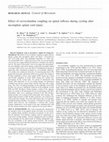
Journal of Neurophysiology, Dec 1, 2018
Spinal networks in the cervical and lumbar cord are actively coupled during locomotion to coordin... more Spinal networks in the cervical and lumbar cord are actively coupled during locomotion to coordinate arm and leg activity. The goals of this project were to investigate the intersegmental cervicolumbar connectivity during cycling after incomplete spinal cord injury (iSCI) and to assess the effect of rehabilitation training on improving reflex modulation mediated by cervicolumbar pathways. Two studies were conducted. In the first, 22 neurologically intact (NI) people and 10 people with chronic iSCI were recruited. The change in H-reflex amplitude in flexor carpi radialis (FCR) during leg cycling and H-reflex amplitude in soleus (SOL) during arm cycling were investigated. In the second study, two groups of participants with chronic iSCI underwent 12 wk of cycling training: one performed combined arm and leg cycling (A&L) and the other legs only cycling (Leg). The effect of training paradigm on the amplitude of the SOL H-reflex was assessed. Significant reduction in the amplitude of both FCR and SOL H-reflexes during dynamic cycling of the opposite limbs was found in NI participants but not in participants with iSCI. Nonetheless, there was a significant reduction in the SOL H-reflex during dynamic arm cycling in iSCI participants after training. Substantial improvements in SOL H-reflex properties were found in the A&L group after training. The results demonstrate that cervicolumbar modulation during rhythmic movements is disrupted in people with chronic iSCI; however, this modulation is restored after cycling training. Furthermore, involvement of the arms simultaneously with the legs during training may better regulate the leg spinal reflexes. NEW & NOTEWORTHY This work systematically demonstrates the disruptive effect of incomplete spinal cord injury on cervicolumbar coupling during rhythmic locomotor movements. It also shows that the impaired cervicolumbar coupling could be significantly restored after cycling training. Actively engaging the arms in rehabilitation paradigms for the improvement of walking substantially regulates the excitability of the lumbar spinal networks. The resulting regulation may be better than that obtained by interventions that focus on training of the legs only.
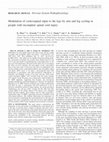
Journal of Neurophysiology, Oct 1, 2017
The spinal cervico-lumbar interaction during rhythmic movements in humans has recently been studi... more The spinal cervico-lumbar interaction during rhythmic movements in humans has recently been studied; however, the role of arm movements in modulating the corticospinal drive to the legs is not well understood. The goals of this study were to investigate the effect of active rhythmic arm movements on the corticospinal drive to the legs (study 1) and assess the effect of simultaneous arm and leg training on the corticospinal pathway after incomplete spinal cord injury (iSCI) (study 2). In study 1, neurologically intact (NI) participants or participants with iSCI performed combinations of stationary and rhythmic cycling of the arms and legs while motor evoked potentials (MEPs) were recorded from the vastus lateralis (VL) muscle. In the NI group, arm cycling alone could facilitate the VL MEP amplitude, suggesting that dynamic arm movements strongly modulate the corticospinal pathway to the legs. No significant difference in VL MEP between conditions was found in participants with iSCI. In study 2, participants with iSCI underwent 12 wk of electrical stimulation-assisted cycling training: one group performed simultaneous arm and leg (A&L) cycling and the other legs-only cycling. MEPs in the tibialis anterior (TA) muscle were compared before and after training. After training, only the A&L group had a significantly larger TA MEP, suggesting increased excitability in the corticospinal pathway. The findings demonstrate the importance of arm movements in modulating the corticospinal drive to the legs and suggest that active engagement of the arms in lower limb rehabilitation may produce better neural regulation and restoration of function. NEW & NOTEWORTHY This study aimed to demonstrate the importance of arm movements in modulating the corticospinal drive to the legs. It provides direct evidence in humans that active movement of the arms could facilitate corticospinal transmission to the legs and, for the first time, shows that facilitation is absent after spinal cord injury. Active engagement of the arms in lower limb rehabilitation increased the excitability of the corticospinal pathway and may produce more effective improvement in leg function.
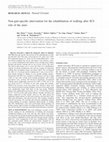
Journal of Neurophysiology, Jun 1, 2018
Arm movements modulate leg activity and improve gait efficiency; however, current rehabilitation ... more Arm movements modulate leg activity and improve gait efficiency; however, current rehabilitation interventions focus on improving walking through gait-specific training and do not actively involve the arms. The goal of this project was to assess the effect of a rehabilitation strategy involving simultaneous arm and leg cycling on improving walking after incomplete spinal cord injury (iSCI). We investigated the effect of 1) non-gait-specific training and 2) active arm involvement during training on changes in over ground walking capacity. Participants with iSCI were assigned to simultaneous arm-leg cycling (A&L) or legs only cycling (Leg) training paradigms, and cycling movements were assisted with electrical stimulation. Overground walking speed significantly increased by 0.092 Ϯ 0.022 m/s in the Leg group and 0.27 Ϯ 0.072m/s in the A&L group after training. Whereas the increases in the Leg group were similar to those seen after current locomotor training strategies, increases in the A&L group were significantly larger than those in the Leg group. Walking distance also significantly increased by 32.12 Ϯ 8.74 m in the Leg and 91.58 Ϯ 36.24 m in the A&L group. Muscle strength, sensation, and balance improved in both groups; however, the A&L group had significant improvements in most gait measures and had more regulated joint kinematics and muscle activity after training compared with the Leg group. We conclude that electrical stimulation-assisted cycling training can produce significant improvements in walking after SCI. Furthermore, active arm involvement during training can produce greater improvements in walking performance. This strategy may also be effective in people with other neural disorders or diseases. NEW & NOTEWORTHY This work challenges concepts of taskspecific training for the rehabilitation of walking and encourages coordinated training of the arms and legs after spinal cord injury. Cycling of the legs produced significant improvements in walking that were similar in magnitude to those reported with gait-specific training. Moreover, active engagement of the arms simultaneously with the legs generated nearly double the improvements obtained by leg training only. The cervico-lumbar networks are critical for the improvement of walking.








Uploads
Papers by Vivian Mushahwar